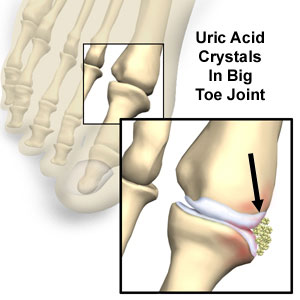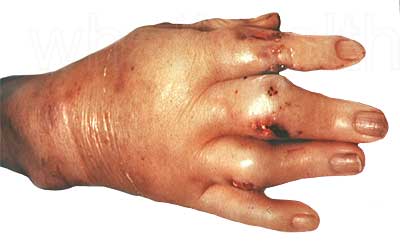Gout Information
Click here to scroll to the list of available medications ↓
Gout, or gouty arthritis, I defined as an attack of a metabolic disease which deposits uric acid in the joints. This can be a very painful disease, and can be classified as acute or chronic. Gout typically attacks the joints of the legs and feet, causing mobility problems. Gout is similar to severe arthritis.
The onset of gout, whether acute or chronic, may begin with stiffness in the joints, followed by joint pain. The joint may swell and become warm to the touch and red in appearance. The patient may develop a fever and a skin lump that is white an chalky in appearance and may even drain a chalky material. Joint pain often begins suddenly and typically affects the great toe, knee, and ankle joints. It is rare that only one joint is affected.
Gout is caused by the metabolism over-producing uric acid. Sometimes the metabolism produces the same amount of uric acid but the kidneys are not able to eliminate enough uric acid from the system. Diseases such as diabetes, obesity, sickle cell anemia, or kidney disease may develop gout as a side effect of their condition. Some drug therapies may also interfere with the body’s ability to excrete uric acid.

People with metabolic disorders, obesity, kidney disease, sickle cell anemia, diabetes, and some cancers are at risk for gout. Men, postmenopausal women, and people who drink alcohol are at a significantly higher risk for gout. Despite these risk factors, gout can occur to anyone who has a build up of uric acid in their system.
When a patient presents with complaints of sudden onset joint pain, redness and swelling of the joints, and a chalky white skin sore, tests are done to determine whether or not the cause is gout. A physical examination may or may not reveal uric acid crystals, and thus a test called a synovial fluid analysis is performed to determine the presence of uric acid crystals. Blood tests can reveal elevated levels of uric acid. Joint x-rays may be taken but can come back as normal if gout is present. A blood differential and a urine test can often quickly and most inexpensively rule out or determine of the patient is presenting with gout.
Complications associated with gout include side effects from the medications to relieve gout pain, the development on chronic gouty arthritis, kidney stones, and eventual kidney dysfunction. Provided those with acute gout attacks receive proper treatment, most patients with gout tend to live a normal life. Acute gout may at any time turn into chronic gouty arthritis despite treatment, but it does not necessarily do so.

When treating gout, there are two goals. The first goal is to address the pain and inflammation of the current attack and the second goal is to attempt to prevent future attacks. The pain associated with an acute attack can be treated with medications such as NSAIDs, corticosteroids, or codeine or other analgesics. Changes in diet may be recommended, as eliminating purines from the diet can help reduce gout attacks. Organ meat, beer, wine, and some common types of fish contain high levels of purines that can contribute to a gout attack. A daily use of a prescribed colchicine or allopurinol can help reduce the risk of future attacks by reducing uric acid levels present in the blood stream.
Gout can be a very painful disease when it attacks. Changes in diet and the use of daily medications can prevent future attacks. While most people with gout are able to control future attacks and live a normal life, the patient should contact the physician immediately if symptoms worsen or refuse to improve even with treatment. Some patients are fortunate and despite one attack, proper care prevents any future attacks. Those living with chronic gouty arthritis need to retain an activity level, and attempt to prevent the worsening of symptoms by just sitting around. The disorder is not preventable, only care after a gout attack can help prevent another gout attack. Some patients, despite changes in their diet, daily medications, and other influential factors of providing a high level of self care may still experience gout attacks on a regular basis.
While gout has no cure, maintaining physician visits and following physician instructions can lead to fewer attacks for most patients. Even if a gout attack has not occurred in years, it is still important to list gout as a medical condition whenever filling out paperwork for a new physician, as treatment options and therapies are continually advancing throughout the years.